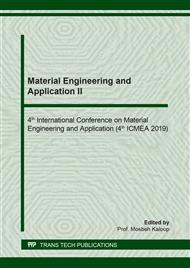p.3
p.9
p.14
p.20
p.26
p.36
p.41
p.48
Influence of Nano-Silica Dosage on Properties of Cement Paste Incorporating with High Calcium Fly Ash
Abstract:
Nanotechnology is receiving widespread attention in many industrial sectors, including construction material industry. One of the nano-scale admixtures, which has the potential to enhance the performance of cement and concrete, is known as Nano-silica (n-SiO2). In general, fly ash (FA) is currently used in cement and concrete industry for replacing the consumption of Portland cement (OPC) to reduce its production cost as well as to improve some specific required properties, e.g., workability or low internal heat liberation. However, the strength of hardened Portland cement is normally decreased when a higher amount of fly ash is presented. This research article is therefore pointed on the influence of nano-silica dosage on the properties of cement paste incorporating with high calcium fly ash. Seven different proportions of OPC:FA were prepared viz. 100:0, 80:20, 60:40, 50:50, 40:60, 20:80 and 0:100 by weight. The commercial grade nano-silica (in liquid form) was used as an admixture in those mixes by 0.0, 0.5, 1.0 and 1.5 wt% of the mixing water with a water-to-binder (w/b) ratio of 0.30. The results indicated that the addition of n-SiO2 improved the compressive strength of all mixtures (with and without high calcium FA) as the presence of n-SiO2 can be a source of silica and easily contribute to an additional formation of CSH in the cementing system, confirmed by the results of XRD analysis. The main findings show a potential approach of using n-SiO2 as an admixture for cement and concrete construction.
Info:
Periodical:
Pages:
9-13
Citation:
Online since:
May 2020
Authors:
Price:
Сopyright:
© 2020 Trans Tech Publications Ltd. All Rights Reserved
Share:
Citation:


